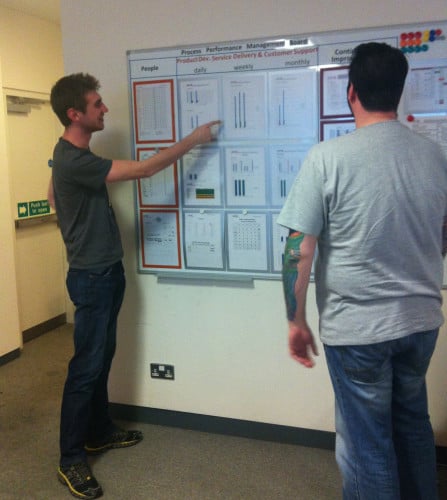Mark's Note: Today's post is a guest post by Nial Toner, who works for PathXL in the UK. I thought this was an interesting post because it touches on leader behaviors and team dynamics in a setting that we don't often talk about here – a technology and R&D setting. I'll be away on vacation through November 6, so there will be guest posts from familiar faces and new faces during that time.
By Nial Toner:
 The last 12 months have seen some big changes to the way we approach things here at PathXL, a digital pathology services company. There have been a number of changes in the overall company approach in the last year, but the most notable change has been the shift towards becoming a Lean enterprise.
The last 12 months have seen some big changes to the way we approach things here at PathXL, a digital pathology services company. There have been a number of changes in the overall company approach in the last year, but the most notable change has been the shift towards becoming a Lean enterprise.
In recent years, software development teams have adopted Lean manufacturing concepts, which aim to produce high quality products, quickly, making effective use of resources and reducing waste.
In the last 12 months, PathXL has moved from cottage industry practices to a world of Lean processes and agile development. We have introduced the philosophy of continuous improvement, by holding kaizen events, creating key performance indicators (KPIs) and improving our visual management process.
Over the past year, PathXL have introduced Lean concepts not only to the research and development (R&D) team but companywide, helping to build strong processes that are improved on a daily basis.
There are three core functionalities behind everything we do here at PathXL as we continue to introduce Lean processes throughout the business.
These are:
- Communication
- Teamwork
- Continuous Improvement
Our lean processes start with two short meetings everyday in our Belfast office. The first is at 9:45 am, where the R&D team has a stand up meeting in their two respective teams to conduct their daily scrum. For those of you unaware of a scrum, it is an agile software development framework which is used for managing software projects and product or application development. The key principle of scrum is the recognition that a customer can change their mind about what they require. During this meeting each team member, in turn, answers three questions with a time limit of one minute.
The three questions asked of the R&D team are as follows:
- Have you any impediments?
- What are you doing today?
- What did you do yesterday?
An example of this new Lean approach at work would begin with Chris from the R&D team saying that progress was slow yesterday because a test box wasn't working correctly. From this Adam (also in the R&D team) notes down a concern on the continuous improvement list. Chris continues by briefly describing the requirement he is working on today and finishes by letting everyone know the progress he made yesterday.
This process is repeated for all team members with an action list being created at the end of the meeting which is aimed at removing all issues from the process.
The second team meeting takes place at 9:50 am, which is signaled with an alarm clock to indicate that it is time for the daily performance meeting. Members of both the PathXL support team and the R&D team huddle around the Visual Management Board. In this meeting ,the teams discuss anything that relates to the product development process with the live support process allowing for a discussion on any problems that have come up. This allows everyone to be aware of any problems in the development process and allows for corrective actions to be taken.
A recent example of this second meeting in action is where Garry (PathXL Support Team) asked all present if there were any communication points within the team. At this point, Steve from the support team stepped up to talk about any support tickets that had been raised.
Through this discussion, the team discovered that a ticket had been raised by a customer who couldn't view images. The teams discussed this issue and Mike (R&D team) thought he might know the resolution, so he suggested that both he and Steve get together after the huddle to discuss in more detail how this customer issue could be resolved.
Adam (R&D team) then stepped up to the visual management board on behalf of the R&D team to inform everyone that everything is on track. This information was then added to the continuous improvement log, with everyone being informed that all customer issues would be fixed by lunch.
The meeting finished and everyone returned to their desk with a clear picture of what work needed to be done during the coming today. These two meetings, which take place inside 15 minutes, allow us to discuss any current issues, communicate the progress and resolve any impediments. Now that's Lean!

Two men who have been instrumental in the progress of Lean processes here at PathXL are Paul Moorhead and Denis Sharp. Both men have made a significant impact on the way we work, with Paul playing a huge role in helping the R&D team get to grips with agile development. This process including the creation of robust software development processes, which looked at projects from the initial requirements through to gathering information along the journey to final delivery of the project. Denis, from BSE Partners, has introduced Lean processes to the wider company and helped to drive out waste and transform quality in all our processes.
About PathXL: PathXL is a global pioneer in the use of web-based solutions for digital pathology. They provide a range of innovative software solutions for use in education, research and clinical sectors worldwide. To find out more on PathXL and the role that lean processes have played in helping the company it's web-based and software solutions for the healthcare industry visit www.pathxl.com.
Nial Toner is a content marketer for PathXL, a UK based company who provide web based solutions for the digital pathology industry and software solutions for use in education, research and clinical sectors worldwide. PathXL incorporated lean processes into their business in 2012 and continue to use the lean philosophy to help improve learnings and offerings for the healthcare industry.
What do you think? Please scroll down (or click) to post a comment. Or please share the post with your thoughts on LinkedIn – and follow me or connect with me there.
Did you like this post? Make sure you don't miss a post or podcast — Subscribe to get notified about posts via email daily or weekly.
Check out my latest book, The Mistakes That Make Us: Cultivating a Culture of Learning and Innovation:








